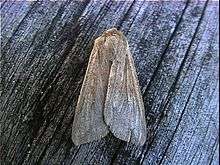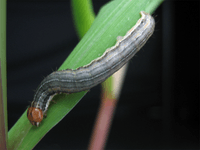Mythimna separata
| Oriental Armyworm | |
|---|---|
 | |
| Scientific classification | |
| Kingdom: | Animalia |
| Phylum: | Arthropoda |
| Class: | Insecta |
| Order: | Lepidoptera |
| Family: | Noctuidae |
| Genus: | Mythimna |
| Species: | M. separata |
| Binomial name | |
| Mythimna separata Walker, 1865 | |
| Synonyms | |
| |
The Northern armyworm, Oriental armyworm or Rice ear-cutting caterpillar (Mythimna separata) is a moth of the Noctuidae family. It is found in China, Japan, South-east Asia, India, Sri Lanka, Eastern Australia, New Zealand, and some Pacific Islands. It is one of the major pest of maize in Asia.[1]
Etymology
They term “Armyworm” is used because of their habit to spread out in a line across a lawn or pasture, and slowly “marching” forward, meanwhile consuming the foliage they encounter.
.jpg)

Description
The wingspan is 35–50 mm. Males lack paired tufts on basal segment of abdomen below.[2] Forewings are grayish-yellow with dark-gray or reddish-yellow tinge. Round and reniform spots are light or yellowish with indistinct edges, whereas reniform spot with white point at lower margin. External wing margin blackened obliquely from top backward, with dark stroke and with a row of dark points. Hindwings are gray, with dark external margin. Antennae thread-like. Eggs have spherical milky-white with thinly reticulate surface. Larvae usually have 6 instars, rarely seven. It reaching 40 mm in length at last instars. Larva has two wide black-brown and one intermediate light dorsal stripe, with black-brown lateral stripe along spiracle line. spiracles brown with black rim. Pupae are yellowish-brown, and shiny.[3]
Ecology
The moth flies from January to April depending on the location. The larvae feed on a range of agricultural plants like Zea mays, Sorghum bicolor and Oryza sativa and are thus considered a pest.[4] Caterpillar do not feed on Momordica charantia due to presence of the triterpenoid glucoside called Momordicine II, which is a natural inhibitor of caterpillar actions.[5]
Infestations
China experiences periodic outbreaks of northern armyworm infestation.[6] The outbreak in 2012 was particularly severe.[7]
Control
Larva can be hand picked and adults can attract using pheromones. Regulation of water level in the fields, and remove alternate hosts from the field are also effective. In biological controls, ducks are good introduction. They can locate larvae hiding in the soil or at the base of plants easily and prey on them. Introduction of Cotesia ruficrus, and Eupteromalus parnarae also parasitized he larva. Selective pesticides and weedicides can also used in the field. Integrated pest management methods undertaken by governments.[8]
See also
- African armyworm (Spodoptera exempta) (Africa)
- Common armyworm or true armyworm (Mythimna unipuncta) (North and South America)
- Fall armyworm (Spodoptera frugiperda) (North and South America)
References
- ↑ "First Record of Armyworm, Mythimna separata (Haworth) as a serious pest of maize in Kullu (HP) India and recommendations for its integrated management". Taylor & Francis Group. Retrieved 4 August 2016.
- ↑ Hampson G. F. (1892). "The Fauna Of British India Including Ceylon And Burma Moths Vol-ii". Digital Library of India. p. 558. Retrieved 4 July 2016.
- ↑ "Pests-Oriental Armyworm". Interactive Agricultural Ecological Atlas of Russia and Neighboring Countries. Retrieved 4 August 2016.
- ↑ "Mythimna (Pseudaletia) separata (Walker)". ICAR-National Bureau of Agricultural Insect Resources. Retrieved 4 August 2016.
- ↑ "Mythimna separata (Walker, 1865". Butterfly House. Retrieved 4 August 2016.
- ↑ Wang GP, et al. The role of nectar plants in severe outbreaks of armyworm Mythimna separata (Lepidoptera: Noctuidae) in China. Bull Entomol Res. 2006 Oct;96(5):445-55.
- ↑ Staff, ChinaDaily. August 14, 2012. China warns of armyworm outbreak
- ↑ "paddy armyworm (Mythimna separata)". Plantwise Technical Factsheet. Retrieved 4 August 2016.
External links
| Wikimedia Commons has media related to Mythimna separata. |